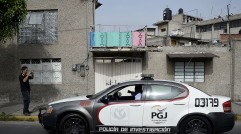Daniel Alarcón Releases 'City of Clowns' Novel About Young Peruvian Journalist
Peruvian-American novelist Daniel Alarcón appeared at the Americas Society Council of the Americas on the evening of Nov. 5 for the launch of his latest publication, "City of Clowns."
The graphic novel, illustrated by acclaimed Peruvian animator Sheila Alvardo, is adapted from the short story published in his book "War by Candelight."
The event was held in collaboration with publisher Riverhead Books, and Alarcón was interviewed by Mexican author Valeria Luiselli ("The Story of My Teeth"). The two spoke in depth about "City of Clowns," including the economics of language, the mechanics of survival and illustrative fiction. Also, Alarcón, who describes himself as "an American writer who happens to write about Latin America, and a Peruvian author who happens to write in English," spoke to Latin Post and other members of the press prior to the event about trends in his writing, Peru, and his previous publications, "War by Candlelight," "At Night We Walk in Circles" and "Lost City Radio."
"I think for my first three books, a lot of it has to do with the idea of Peru, and the idea of what I didn't live through because my family left ... maybe a kind of low-grade survivor's guilt," Alarcón told Latin Post. "My generation was the one where adolescents were scarred by conflict, by all the dark things that were brought to the city where I was born, the city where I would have grown up. [That's apparent] in 'War by Candlelight' and 'Lost City Radio.' Slightly more indirectly [shown] in 'At Night We Walk in Circles.' The spectrum of the war is there, certainly waves of trauma playing out between family and lovers, between fathers and sons, between mothers and daughters, between communities and across class lines. I think that's something that's interesting to me, again and again."
Alarcón also described an interest in and being troubled by criminal justice and crime and punishments and prisons, which is why he's visited Peruvian prisons multiple times. He was once asked to give a reading at a prison, which he changed his life. He regards prison as place that locks others away after society deems them worthless or meaningless.
"City of Clowns" doesn't address the author's low-grade survivor's guilt or the prison industrial system, but instead tells the story of a young Peruvian journalist, Oscar "Chino" Uribe, who unearths sordid truths about his family and has to come to terms with own identity in light of those discoveries.
The idea to create the 144-page graphic novel came to Alarcón after he'd read Joe Sacco's "Safe Area Goražde." He handed the book to his friend Alvardo, who was the art director at the Peruvian magazine Etiqueta Negra at the time and asked her if she would want to do something like that, and she said yes.
The two chose to illustrate Alarcón's "City of Clown," which was originally published in the New Yorker in 2003. The story's inspiration began one morning in front of a church in central Lima when the author was teaching an old girlfriend how to use an old camera. They'd noticed several drunk men who were putting on makeup, clown costumes, giant shoes and colorful wings. They were painting their faces at 8 in the morning, and Alarcón's girlfriend, who was very good at getting people to talk about the economics of their daily lives, asked them to explain the economics of their survival (ie. how many pieces of candy they needed to sell or how many buses they had to ride to make their livings). That moment was when the story began. The 75-page draft of that story was last written in just three weeks while the author was living just outside of Iowa City.
Alvardo and Alarcón failed to work on the book when they briefly lived moments from one another while stationed in Buenos Aires and Lima, and instead they completed the graphic novel over Skype. Projected to take no longer than six months, the book took 18 months to complete. Together, they designed all the pages, defined sections with images, decided which with illustrations replaced what words, and continuously negotiated between language and depictions. Originally published in Spanish in Peru in 2013, the graphic novel quietly captures the journey of language, from English, to Spanish, to English. Through its voyage, nouns and verbs transformed because words carry different weights in different languages.
"There was a certain fury to the writing that has always been there; after going through so many iterations, each edit was very considered. I added a certain slowness that the first draft or any of the other drafts had," Alarcón told Luiselli. "The language comes alive because of the images and the images come alive because of the language. And we worked to use very Peruvian Spanish, not the horrible very neutral Spanish."
Subscribe to Latin Post!
Sign up for our free newsletter for the Latest coverage!













